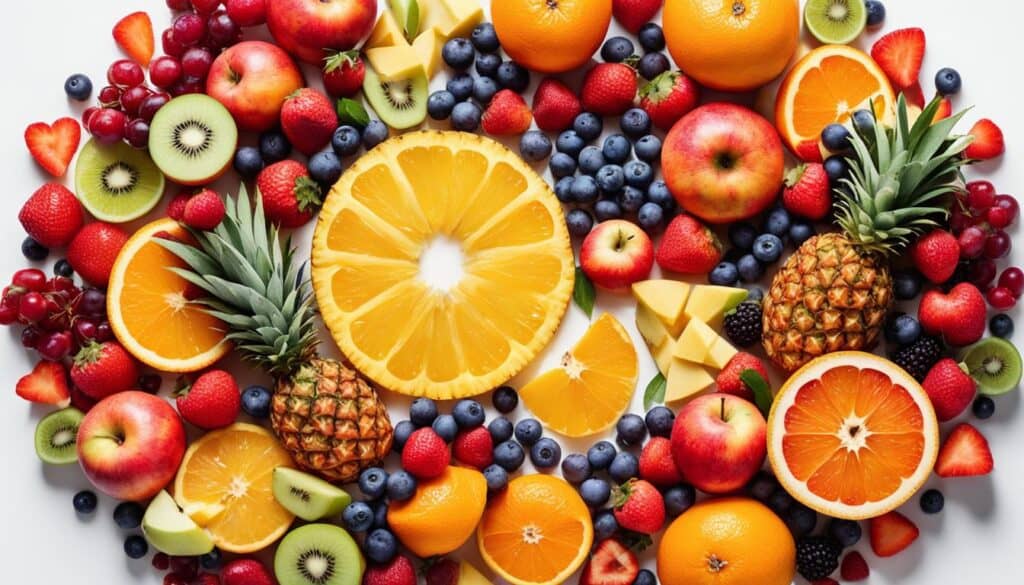Have you ever wondered why fruits are so sweet and delicious? It’s not just by chance – nature has a sugary secret that makes fruits a delightful treat. The natural sweetness in fruits comes from sugars like fructose and lactose, which are not only responsible for the sweet taste but also provide essential nutrients and sustained energy. Understanding fruit flavor and the difference between natural and added sugars is essential for maintaining a healthy diet.
Key Takeaways:
- Fruits contain fructose and lactose, which provide natural sweetness and essential nutrients.
- Natural sugars in fruits are digested slower than added sugars, helping to stabilize metabolism.
- Added sugars, commonly found in processed foods, can lead to blood glucose spikes and crashes.
- Reading food labels is crucial in identifying hidden sugars and making informed choices.
- It is recommended to limit added sugar intake to maintain a healthy lifestyle.
The Health Benefits of Natural Sugars
When it comes to fruits, their sweetness is just the beginning. While fruits certainly satisfy our cravings for something sweet, they also offer a plethora of health benefits. Packed with essential nutrients like potassium, vitamin C, and folate, fruits are a powerhouse of goodness that goes beyond their delightful taste.
One of the key advantages of consuming fruits is the presence of natural sugars. Unlike added sugars found in processed foods, the natural sugars in fruits are processed more slowly by our bodies. This slow digestion leads to sustained energy and keeps our blood glucose levels elevated for a longer period, preventing sudden spikes and crashes.
By choosing fruits as a source of sugar, we not only satisfy our sweet tooth but also nourish our bodies with vital nutrients. The combination of natural sugars and essential vitamins and minerals makes fruits a well-rounded choice for maintaining overall health.
The Nutritional Powerhouse of Fruits
Let’s take a closer look at some of the incredible nutrients found in fruits:
- Potassium: Known for its role in maintaining healthy blood pressure levels, potassium is essential for supporting cardiovascular health and muscle function.
- Vitamin C: This powerful antioxidant helps boost our immune system, promotes collagen production for healthy skin, and aids in the absorption of iron.
- Folate: Also known as vitamin B9, folate is crucial for cell growth and development, making it especially important for pregnant women to ensure proper fetal development.
Fruits offer an array of essential nutrients, making them more than just a sweet treat. They provide us with vital vitamins, minerals, and antioxidants that support our overall health and well-being.
By incorporating a variety of fresh fruits into our diet, we can reap the many benefits they offer. Incorporating fruits into our daily meals can help us achieve a balanced and nutritious diet, while also satisfying our craving for a sweet and refreshing snack.
The Dangers of Added Sugars
Added sugars are a common ingredient in many processed foods like sugary cereals, candy, and desserts. While they may enhance the taste, these added sugars can have detrimental effects on our health. Consuming excess added sugars can lead to rapid fluctuations in blood glucose levels, causing a phenomenon known as a “sugar crash.”
When we consume foods high in added sugars, our bodies quickly process these sugars, leading to a fast increase in blood sugar levels. However, this spike is soon followed by a sharp drop in blood glucose, causing a sugar crash. During a sugar crash, you may experience symptoms such as hunger, irritability, and intense cravings for more sugary foods.
Understanding the impact of added sugars on our bodies is crucial in making informed choices about our sugar intake. By being aware of the science behind fruit sweetness and the dangers of added sugars, we can take steps to reduce our consumption and protect our overall health.
| The Science Behind Fruit Sweetness | Added Sugars | Sugar Crash |
|---|---|---|
| Contains naturally occurring sugars | Commonly found in processed foods | Causes rapid fluctuations in blood glucose levels |
| Provides essential nutrients and sustained energy | Can lead to negative health effects | Leads to symptoms such as hunger, irritability, and intense cravings |
| Digested slower than added sugars | Processed quickly by the body | Results in a sharp drop in blood sugar levels |
Identifying Natural and Added Sugars
When it comes to sugar consumption, not all sugars are created equal. While natural sugars found in fruits provide essential nutrients, added sugars can have negative effects on our health. That’s why it’s crucial to know how to identify and differentiate between natural and added sugars.
To make informed choices about sugar intake, it’s important to read food labels carefully. Look out for terms such as “sugar-free,” “reduced sugar,” or “no added sugars.” These labels provide valuable information about the sugar content of a product.
Sugar-Free:
The term “sugar-free” indicates that a product contains less than 0.5 grams of sugar per serving. This makes it a suitable option for those looking to reduce their sugar intake. However, it’s essential to remember that “sugar-free” doesn’t necessarily mean completely devoid of all sugars or sweeteners.
Reduced Sugar:
A product labeled as “reduced sugar” means that it contains 25% less sugar compared to the standard variety. While this is a step in the right direction, it’s still important to consider the overall sugar content and opt for lower-sugar alternatives whenever possible.
No Added Sugars:
The label “no added sugars” indicates that no sugars or sugar-containing ingredients were added during processing. This label is particularly important for those trying to avoid hidden sugars or added sweeteners in their food. However, it’s essential to note that a product labeled as “no added sugars” may still contain naturally occurring sugars.
In addition to reading labels, it’s crucial to check the ingredient lists for hidden sugars. Common sources of hidden sugars include ingredients such as corn syrup, fruit juice concentrates, and high-fructose corn syrup. Being aware of these hidden sources can help you make healthier choices and reduce your overall sugar intake.
By identifying natural and added sugars, you can make informed decisions about the products you consume and take control of your sugar consumption. Remember, knowledge is power when it comes to maintaining a balanced and healthy diet.
Recommended Sugar Intake

Understanding the recommended amount of sugar intake is crucial in maintaining a healthy lifestyle. The average American consumes over 70 grams of added sugar daily, which exceeds the recommended limits. For optimal health, it is suggested that women limit their added sugar consumption to less than 24 grams per day, while men should aim for no more than 36 grams.
Excessive sugar intake has been linked to various negative health effects, including obesity, type 2 diabetes, heart disease, and dental problems. By being mindful of our sugar consumption, we can reduce the risk of these health complications and prioritize our well-being.
Recommended Daily Added Sugar Intake
| Population | Recommended Added Sugar Intake |
|---|---|
| Women | Less than 24 grams per day |
| Men | No more than 36 grams per day |
Reducing added sugar intake can have a positive impact on overall health and well-being. By being aware of the recommended sugar limits and making conscious choices, we can take control of our sugar consumption and make healthier choices for ourselves and our families.
Strategies for Reducing Sugar Intake
Reducing sugar intake can be a challenging endeavor, but there are effective strategies to help you achieve your goals. By making smart food choices and adopting healthy behaviors, you can cut out sugars and improve your overall well-being.
Prioritize Health and Essential Nutrients
When seeking to reduce sugar consumption, it’s important to prioritize your health and focus on essential nutrients. Opt for low-fat and no-sugar-added foods that provide the necessary vitamins and minerals your body needs to function properly. By selecting nutritious options, you can satisfy your hunger and cravings without compromising your well-being.
For instance, replace sugary desserts with fresh fruit or indulge in a naturally sweetened yogurt instead of reaching for sugary snacks. These food swaps can help you cut back on added sugars while still enjoying delicious flavors.
Understand Discretionary Calorie Budgets
Understanding your discretionary calorie budget is another key step in reducing sugar intake. Discretionary calories refer to the extra calories you can consume after meeting your nutrient needs. By being mindful of these discretionary calories and allocating them wisely, you can make better choices regarding sugar consumption.
Pairing sugary treats with protein or fat can help stabilize your blood glucose levels, preventing the rapid rise and fall associated with consuming sugary foods alone. Enjoying a small piece of dark chocolate with a handful of nuts or spreading nut butter on a slice of whole grain toast can provide a satisfying snack while keeping your sugar intake in check.
Swap Sugary Options with Healthier Alternatives
“Small changes can make a big difference in reducing sugar intake.”
Small changes in your daily routine can yield significant results when it comes to cutting out sugars. Consider implementing food swaps to replace sugary options with healthier alternatives. For example, use mashed avocado as a flavorful condiment instead of mayonnaise in your sandwiches or wraps. Avocado provides a creamy texture and adds a nutritious element to your meal without the added sugars.
Instead of reaching for soda, satisfy your thirst with sparkling water infused with a splash of citrus juice. This refreshing option gives you the carbonation you crave while eliminating the excessive sugar content found in traditional sodas.
The Health Benefits of Fruits

When it comes to promoting good health, fruits are a powerhouse of nutrients and offer numerous benefits. Studies have shown that consuming a variety of fruits can help protect against certain cancers, heart disease, stroke, and other conditions.
Fruits also play a significant role in weight control. Including a daily serving of fruit in your diet has been linked to half a pound of weight loss over a four-year period. This is due to the high fiber content in fruits, which helps keep you feeling fuller for longer, reducing the chances of overeating.
One of the key reasons fruits are so beneficial is their abundance of antioxidants. Antioxidants, such as flavonoids found in fruits like apples, berries, and pears, have been shown to have a positive impact on metabolism and weight maintenance. These antioxidants help neutralize harmful free radicals in the body, reducing the risk of chronic diseases and supporting overall health.
So, whether you’re looking to maintain a healthy weight or improve your overall well-being, incorporating a variety of fruits into your diet is a smart choice. The combination of vitamins, minerals, fiber, and antioxidants found in fruits contributes to their impressive health-promoting properties.
Benefits of Fruits:
- Protection against certain cancers.
- Reduced risk of heart disease and stroke.
- Support in weight control and management.
- Rich source of essential vitamins and minerals.
- High fiber content for digestive health and satiety.
- Antioxidant properties that help fight free radicals.
By incorporating a variety of fruits into your daily diet, you can enjoy these health benefits while enjoying the natural sweetness and delicious flavors nature has to offer.
The Unique Components of Fruit Juices
Fruit juices are a popular choice for quenching thirst and obtaining essential vitamins and minerals. However, it’s important to understand the unique composition of fruit juices compared to whole fruits.
Unlike whole fruits, fruit juices lack the fiber that is naturally present in the fruit. Fiber plays a crucial role in digestion and helps slow down the absorption of sugars into the bloodstream. Without fiber, the sugars in fruit juices are absorbed more quickly by the body, leading to a faster increase in blood glucose levels compared to consuming whole fruits.
Additionally, fruit juices are a more concentrated source of sugars and calories. When fruits are juiced, the natural sugars become more concentrated, resulting in a higher sugar content per serving. This can contribute to an increased calorie intake if consumed in excess.
While fruit juices do contain valuable vitamins and minerals, it’s important to consider the higher sugar content and lack of fiber. Opting for whole fruits allows you to benefit from the fiber content, which aids in digestion and provides a feeling of fullness. Aim to consume 1½ to 2 cups of whole fruits per day to maximize the health benefits.
Table: A comparison of the nutritional components of fruit juices and whole fruits
| Nutritional Component | Fruit Juices | Whole Fruits |
|---|---|---|
| Fiber | Low to none | Significant amount |
| Sugar Content | Higher concentration | Lower concentration |
| Calorie Content | Higher | Lower |
| Vitamins and Minerals | Present | Present |
As seen in the table above, while fruit juices do provide essential vitamins and minerals, they are also higher in sugar and calories compared to whole fruits. Therefore, incorporating a variety of whole fruits into your diet is recommended for a balanced and nutritious intake.
The Importance of Fruit Flavor

The flavor of fruits plays a crucial role in consumer preference and their decision to make repeated purchases. As fruit growers, we must prioritize flavor development to increase profitability and create a positive eating experience for consumers. Producing fruits with complex and delicious flavors enhances consumer satisfaction and boosts their willingness to buy.
Fruit flavor is a delightful combination of taste and aroma, influenced by the quantity and composition of sugars, acids, and volatile compounds. The balance of these elements determines the unique flavor profile of each fruit variety. By understanding the factors that contribute to flavor, we can harness their potential to create exceptional fruits that captivate consumers.
The flavor of fruits goes beyond just satisfying our taste buds. It evokes memories, emotions, and connects us to nature. By focusing on developing amazing fruit flavors, we can nurture a love for fruits and encourage healthier eating habits among consumers.
The Role of Consumer Preference
Consumer preference is a driving force behind the demand for specific fruit flavors. By understanding what consumers enjoy, we can tailor our fruit production to meet their desires. Conducting surveys, taste tests, and market research allows us to gather valuable insights into consumer preferences, helping us develop fruits that align with their taste expectations. By delivering fruits with exceptional flavor, we can satisfy cravings and create a loyal customer base.
Factors Influencing Flavor Development
Achieving outstanding fruit flavor involves considering various factors at every stage of the fruit’s journey, from the orchard to the consumer’s plate. These factors include:
- Genetics: The genetic makeup of a fruit variety determines its inherent flavor potential. Some varieties naturally have enhanced sweetness, acidity, or aromatic compounds.
- Environmental Factors: The climate, soil composition, sunlight, and temperature during the growth and ripening stages impact fruit flavor. These external factors influence the balance of sugars, acids, and other flavor-enhancing compounds.
- Orchard Management: Proper crop load management, irrigation practices, and nutrient supply can significantly impact fruit flavor. Taking care of the fruit trees’ health ensures they develop optimal flavors when they reach maturity.
- Fruit Maturity: Harvesting fruits at their peak of ripeness affects their flavor. Waiting until the fruit reaches its maximum flavor potential ensures a delightful eating experience for consumers.
- Postharvest Factors: Proper handling, storage conditions, and transportation methods are essential for maintaining fruit flavor. Any mishandling during these stages can negatively impact the taste and aroma of the fruits.
Investing in Flavor Development
As fruit growers, focusing on flavor development is a wise investment that can yield significant returns. By consistently delivering fruits with exceptional flavors, we build a reputation for quality and taste among consumers. This reputation leads to increased consumer satisfaction, word-of-mouth recommendations, and ultimately, greater profitability.
Investing in research and development, exploring new fruit varieties, and refining growing and postharvest techniques are all crucial steps in flavor development. By staying ahead of consumer preferences, we can continue to provide fruits that delight the senses and cultivate a strong demand for our products.
| Benefits of Fruit Flavor Development | Actions for Fruit Growers |
|---|---|
| Enhances consumer satisfaction and eating experience | Invest in research and development |
| Increases consumer willingness to repurchase | Explore new fruit varieties |
| Builds a reputation for quality and taste | Refine growing and postharvest techniques |
| Boosts profitability | Stay ahead of consumer preferences |
Measuring Fruit Flavor

Fruit flavor is a fascinating combination of taste and aroma that can be evaluated through various methods. Both sensory evaluation and instrumental measurements play a crucial role in understanding the complex attributes that contribute to fruit flavor.
Sensory Evaluation
Sensory evaluation methods involve human responses to taste, aroma, and other sensory attributes of fruits. Trained panelists assess the flavor profile of fruits based on their personal experiences and perceptions. By tasting and smelling the fruits, panelists can provide valuable insights into the taste, aroma, texture, and overall quality of the fruit.
Sensory evaluation allows us to uncover the nuances of fruit flavor and understand the preferences of consumers. It helps us identify the unique characteristics that make certain fruits more desirable than others.
Instrumental Measurements
Instrumental measurements provide objective data to support sensory evaluation findings. These measurements quantify specific attributes of fruits, such as sugar content and acidity, helping to provide a comprehensive understanding of fruit flavor.
| Measurement | Instrument |
|---|---|
| Sugar Content | Refractometer |
| Acidity | pH Meter |
| Aroma Volatiles | Gas Chromatography-Mass Spectrometry (GC-MS) |
Measuring sugar content is essential in determining the sweetness of fruits, while acidity provides crucial information about the tartness or sourness. Aroma volatiles, which contribute to the distinct scent of fruits, are more challenging to measure but can be analyzed using GC-MS.
By combining sensory evaluation and instrumental measurements, researchers and growers can gain valuable insights into the flavor characteristics of different fruit varieties. This knowledge helps in the selection and development of fruits that cater to consumer preferences and expectations.
Factors Affecting Fruit Flavor

When it comes to fruit flavor, there are several factors at play that contribute to the delicious taste and aroma we love. Understanding these factors can help growers produce fruits that meet consumer expectations and deliver superior quality. Let’s explore the key elements that influence fruit flavor:
Genetics:
The genetics of the fruit variety and the choice of rootstock have a significant impact on flavor potential. Different fruit varieties have distinct flavor profiles, influenced by the balance of sugars, acids, and volatile compounds. The selection of the right rootstock can also influence fruit flavor by affecting nutrient uptake and overall plant vigor.
Environmental Factors:
The environment in which fruits grow plays a crucial role in flavor development. Factors such as temperature, humidity, and sunlight exposure during the growing season interact with the genetic background of the fruit variety. For example, apples grown in cooler climates generally have a more vibrant flavor compared to those grown in warmer regions.
Orchard Management:
Effective orchard management practices can greatly impact fruit flavor. Crop load management, which involves controlling the number of fruits on a tree, allows for optimal resource allocation and leads to more concentrated flavors. Proper irrigation and nutrition management ensure that the fruit receives the necessary nutrients for flavor development.
Fruit Maturity:
Harvesting fruits at the right maturity stage is essential to maximize flavor development. Each fruit has its own optimal stage of ripeness where sugars are at their peak, acids are balanced, and flavor compounds have fully developed. Harvesting too early or too late can result in subpar flavor.
Postharvest Factors:
The postharvest handling of fruits can significantly influence flavor retention. Storage conditions, such as temperature, humidity, and ethylene exposure, impact the flavor stability and shelf life of fruits. Proper handling and storage practices are crucial to ensure that the fruits reach consumers with their full flavor intact.
| Factors Affecting Fruit Flavor | Description |
|---|---|
| Genetics | The fruit variety and choice of rootstock determine the intrinsic flavor potential. |
| Environmental Factors | Temperature, humidity, and sunlight during the growing season interact with genetics. |
| Orchard Management | Crop load management, irrigation, and nutrition contribute to fruit flavor. |
| Fruit Maturity | Harvesting fruits at the optimal stage of ripeness enhances flavor development. |
| Postharvest Factors | Proper handling and storage practices maintain fruit flavor after harvest. |
The combination of these factors creates distinct and delightful fruit flavors that captivate our taste buds. By understanding and managing these components, growers can produce fruits that satisfy consumer preferences for exceptional flavor and quality.
Image: Factors Affecting Fruit Flavor – genetics, environmental factors, orchard management, fruit maturity, postharvest factors.
Conclusion
In conclusion, the sweetness of fruits comes from natural sugars that offer essential nutrients and sustained energy. Unlike added sugars in processed foods, the sugars in fruits are digested slower, helping to stabilize metabolism and prevent blood glucose spikes. However, it is crucial to identify hidden sugars and monitor overall sugar intake to avoid negative health effects.
Fruits not only provide sweetness but also offer a wide range of health benefits. Packed with essential nutrients like potassium, vitamin C, and folate, they support overall health and can aid in weight control. Incorporating fruits into your diet can satisfy cravings while keeping blood glucose levels elevated for a longer duration.
Understanding the science behind fruit flavor is essential for growers. Factors such as genetics, environmental conditions, orchard management, fruit maturity, and postharvest practices all influence the flavor of fruits. By prioritizing flavor development, growers can produce fruits that meet consumer expectations, enhancing the overall eating experience and increasing profitability.
Overall, fruits provide a natural and nutritious alternative to added sugars. Their unique flavor, combined with their health benefits, makes them a valuable addition to any diet. By making informed choices about sugar intake and prioritizing flavor development, we can enjoy the deliciousness of fruits while maintaining a healthy lifestyle.
FAQ
Why are fruits sweet?
Fruits are sweet because they contain natural sugars like fructose and lactose. These sugars provide essential nutrients and sustained energy.
What other benefits do fruits offer besides sweetness?
Fruits are packed with essential nutrients like potassium, vitamin C, and folate. They also offer sustained energy and help maintain stable blood glucose levels.
What are the dangers of added sugars?
Added sugars, commonly found in processed foods, can lead to blood glucose spikes and crashes. Consuming excessive added sugars can have negative health effects.
How can I identify natural and added sugars?
Reading food labels is crucial. Terms like “sugar-free” and “no added sugars” indicate the absence or minimal amount of added sugars. Hidden sugars can be found in ingredient lists.
What is the recommended sugar intake?
Women should consume less than 24 grams of added sugar per day, while men should limit their intake to 36 grams. However, the average American consumes over 70 grams of added sugar daily.
What strategies can I use to reduce sugar intake?
Prioritizing health by choosing low-fat and no-sugar-added foods, understanding discretionary calorie budgets, and making food swaps can help reduce sugar consumption.
What are the health benefits of fruits?
Fruits can help protect against certain cancers, heart disease, stroke, and other conditions. They also play a role in weight control and contain antioxidants.
How are fruit juices different from whole fruits?
Fruit juices lack the fiber found in whole fruits, leading to a faster increase in blood glucose levels. It is recommended to opt for whole fruits for maximum health benefits.
Why is fruit flavor important?
Fruit flavor is important for consumer preference and repeated purchases. It is influenced by the quantity and composition of sugars, acids, and volatile compounds.
How is fruit flavor measured?
Fruit flavor can be measured through sensory evaluation methods and instrumental measurements like sugar content, acidity, and aroma volatiles.
What factors affect fruit flavor?
Fruit flavor development is influenced by genetics, environmental factors, orchard management practices, fruit maturity, and postharvest factors like storage conditions.
What is the conclusion about fruit flavor?
By prioritizing flavor development, growers can enhance the consumer’s eating experience and increase profitability.





Leave a Reply